The German equivalent of the Centers for Disease Control says the number of active cases of tuberculosis (TB) diagnosed in Germany increased 30 percent in one year, jumping to 5,852 in 2015, up from 4,488 in 2014. That dramatic increase slowed significantly in 2016, when 5,915 cases were reported.
The two consecutive years of increases in TB are a marked contrast to the decade of steady annual declines from 2002–when about 7,700 cases were diagnosed–to 2012, when about 4,100 cases were reported. (See pages 210 and 211 of The Infectious Disease Epidemiology Annual Report released by Germany’s Robert Koch Institute (RKI) on July 12.)
The stunning increase in the incidence of TB in 2015 came at the same time Germany experienced a massive wave of immigration from high TB burden countries in Africa and the Middle East.
“Net migration of foreign people amounted to 1.14 million. This is the highest net immigration of foreigners ever recorded in the history of the Federal Republic of Germany,” DW.com reported.
The figure marks a 49-percent increase compared to 2014, which witnessed a net migration of 577,000 people.
The office registered in 2015 under two million immigrants arriving in Germany, while 860,000 departed again. . .
For the first time immigrants from non-European countries outnumbered those from Europe.
The population of Germany in 2016 was 80.6 million, according to United Nations data. The rate of TB increased from 5.6 per 100,000 residents in 2014 to 7.3 per 100,000 residents in 2016.
As a point of comparison, the rate of TB in the United States over the same time period decreased slightly from 3.0 per 100,000 residents in 2014 to 2.9 per 100,000 residents in 2016.
More than 67 percent of all cases of TB in the United States in 2016 were foreign-born, up from 22 percent in 1986. Similar data was not included in the RKI report on Germany.
Writing at the Gatestone Institute, Soeren Kern notes:
The [RKI] report shows increased incidences in Germany of adenoviral conjunctivitis, botulism, chicken pox, cholera, cryptosporidiosis, dengue fever, echinococcosis, enterohemorrhagic E. coli, giardiasis, haemophilus influenza, Hantavirus, hepatitis, hemorrhagic fever, HIV/AIDS, leprosy, louse-borne relapsing fever, malaria, measles, meningococcal disease, meningoencephalitis, mumps, paratyphoid, rubella, shigellosis, syphilis, toxoplasmosis, trichinellosis, tuberculosis, tularemia, typhus and whooping cough.
The increases by disease in Germany are staggering, Kern adds:
- The incidence of Hepatitis B, for example, has increased by 300% during the last three years, according to the RKI.
- During the past two years, at least 48 people in Germany were diagnosed with [Louse-Borne Relapsing Fever] LBRF, a disease that was unheard of in the country before the migration crisis in 2015.
- Around 700 people in Germany have been diagnosed with measles during the first six months of 2017, compared with 323 cases in all of 2016… [an] outbreak that health authorities have linked to immigration from Romania.
- In February 2016, a patient who had been infected in Togo, West Africa, was treated and died in Germany. After his death, a Lassa virus infection was confirmed in another person who had professional contact with the corpse of the deceased. The person was treated at an isolation facility and survived the disease. This was the first documented transmission of the Lassa virus in Germany.
- Nearly a thousand people were diagnosed with dengue fever, a mosquito-borne tropical disease, in Germany during 2016. This is up 25% from 2014, when 755 people were diagnosed with the disease.
- Between 2014 and 2016, more than 200 people in Germany have been diagnosed with echinococcosis, a tapeworm infection. This represents an increase of around 30%.
As Breitbart News has reported, the increase in the number of foreign-born residents in the United States from 11 million in 1985 to 42 million in 2015 has coincided with a similar increase in previously eradicated diseases in the United States:
- The number of communicable TB cases, dubbed active TB, increased by 1.7 percent to 9,563 in 2015, after 23 years of steady decline in the United States. In 1986, 22 percent of the 22,000 active TB cases in the U.S. were foreign born. By 2015, 66 percent of the 9,563 active TB cases were foreign born—a tripling.
- “In 2014, the United States experienced a record number of measles cases, with 667 cases from 27 states reported to CDC’s National Center for Immunization and Respiratory Diseases (NCIRD); this is the greatest number of cases since measles elimination was documented in the U.S. in 2000,” the Centers for Disease Control (CDC) reports.
- In 1976, (whooping cough, or pertussis) had been virtually eradicated here, with only 1,010 cases reported that year. But a decade later, in 1986, the number of reported cases had crept back up over 4,000. Now, in 2014, the reported number of cases have increased to 32,971, more than thirty times the number of cases reported just four decades earlier.
- Once a common illness among children and young adults, cases of mumps in the US have dropped by 99% since a vaccine was introduced in 1967. . . But occurrences crop up, particularly among close-knit communities. The CDC reports that there have been 688 reported cases of mumps in the US in 2015,” Health.com reports.
Public health risks associated with mass migration of refugees from countries in Africa and the Middle East to Western Europe and the United States continue to be significant, and may well be under reported.

COMMENTS
Please let us know if you're having issues with commenting.